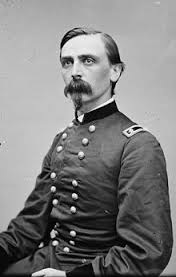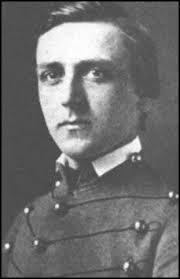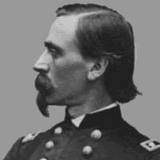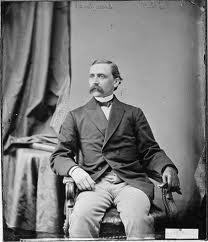 Maine Union Patriot, Adelbert Ames, was not only a valiant Medal of Honor recipient, but also was elected Mississippi Governor after the Civil War. What a great first name. How many Adelbert’s do you know? The meaning of Adelbert, a variant of Albert, means one that is noble, bright and famous. This Maine Patriot eventually attained all three and as a Radical Republican, was appointed, the 27th, then elected, the 30th Governor of the state of Mississippi, the Reconstruction Powder Keg of the south.
Maine Union Patriot, Adelbert Ames, was not only a valiant Medal of Honor recipient, but also was elected Mississippi Governor after the Civil War. What a great first name. How many Adelbert’s do you know? The meaning of Adelbert, a variant of Albert, means one that is noble, bright and famous. This Maine Patriot eventually attained all three and as a Radical Republican, was appointed, the 27th, then elected, the 30th Governor of the state of Mississippi, the Reconstruction Powder Keg of the south.
Adelbert Ames was born October 31, 1835 in Rockland, Maine. His father, Jesse Ames, was a sea-captain and his young son accompanied his father on occasional voyages, as a merchant seaman. Adelbert had a common education of the era and through family connections garnered an appointment to United States Military Academy in 1856 and graduated fifth in his class, less than a month after the onset of the Civil War.
 On graduation, he was commissioned as a second lieutenant and assigned to the artillery near Washington. He drilled volunteers for two months until ordered into the military fiasco, that became the infamous First Battle of Bull Run. While the Union troops were giving way, Ames and his men were holding on. The young Maine officer, was shot in the thigh, but insisted on staying with his men, astride his horse at first, commanding the troops. Later, he sat on an ammunition chest until the regiment was forced to withdraw, whereupon he was carried away in a wagon. His bravery earned him a temporary promotion to major and later a Congressional Medal of Honor, which was finally awarded in 1893.
On graduation, he was commissioned as a second lieutenant and assigned to the artillery near Washington. He drilled volunteers for two months until ordered into the military fiasco, that became the infamous First Battle of Bull Run. While the Union troops were giving way, Ames and his men were holding on. The young Maine officer, was shot in the thigh, but insisted on staying with his men, astride his horse at first, commanding the troops. Later, he sat on an ammunition chest until the regiment was forced to withdraw, whereupon he was carried away in a wagon. His bravery earned him a temporary promotion to major and later a Congressional Medal of Honor, which was finally awarded in 1893.
Returning to duty after recovering from his wound, he saw significant action during the Peninsula Campaign in the spring of 1862 and received a brevet promotion to lieutenant colonel. Ames sought higher rank and realized that quicker promotion was available in the infantry. He returned to Maine and lobbied for a commission to command an infantry regiment. On Aug. 20, 1862, he was given command of the 20th Maine Volunteer Infantry. The second-in-command assigned to him was an untried college professor named Joshua Lawrence Chamberlain.
 During the Union defeat at the Battle of Fredericksburg, General Ambrose Burnside’s regiments repeatedly failed to capture a sunken, walled road in the area of the battlefield called Marye’s Heights. Burnside ordered General Joseph Hooker to capture the road. Hooker observed the area through field glasses and saw that it was bristling with riflemen. He pleaded to abandon the order, but Burnside repeated it. Hooker then ordered Ames to advance against the road. Adelbert Ames performed heroically, leading the 20th Maine across the field, the only regimental commander to do so. An officer from a regiment pinned down in the field later said Ames calmly led the 20th to his position and told him quietly, “I will move over your line and relieve your men.” The road indeed proved to be impregnable and the Union Army had to withdraw and of the 36 casualties in his unit, all had been behind Ames.
During the Union defeat at the Battle of Fredericksburg, General Ambrose Burnside’s regiments repeatedly failed to capture a sunken, walled road in the area of the battlefield called Marye’s Heights. Burnside ordered General Joseph Hooker to capture the road. Hooker observed the area through field glasses and saw that it was bristling with riflemen. He pleaded to abandon the order, but Burnside repeated it. Hooker then ordered Ames to advance against the road. Adelbert Ames performed heroically, leading the 20th Maine across the field, the only regimental commander to do so. An officer from a regiment pinned down in the field later said Ames calmly led the 20th to his position and told him quietly, “I will move over your line and relieve your men.” The road indeed proved to be impregnable and the Union Army had to withdraw and of the 36 casualties in his unit, all had been behind Ames.
Adelbert Ames commanded a brigade at the Battle of Gettysburg. When his commanding officer was wounded, he took command of the division and held the line at East Cemetery Hill. On the third day of battle, Ames was riding with a general from Meade’s staff and found troops cheering and waving their hats at them. Ames congratulated the general but was told they were the 20th Maine, Ames’ old unit and they were cheering him.The 20th Maine, under Colonel Joshua Chamberlain, performed heroically at Gettysburg, using a bayonet charge to repel the Confederates at Little Round Top, holding the Union force’s left. Chamberlain, a college professor, regarded Ames, a professional soldier, as his mentor.
After Gettysburg, Ames was made a colonel in the regular Army and served in South Carolina and Florida. In 1864, his division became part of the 10th Corps under General Benjamin Butler and took part in the Bermuda Hundred and Petersburg campaigns in Virginia. In January 1865, Ames led the successful assault on Fort Fisher, which guarded the Cape Fear River and Wilmington, N.C. Ames attacked on Jan. 15, personally directing his troops. He was conspicuous in his brigadier general’s dress uniform, unconcerned about repeated fire from sharpshooters. During the night, they captured the fort and took 2000 prisoners and 72 cannon. The attack cost him 650 men killed and wounded, also four of the six staff officers, that he took into the fort. Ames was rewarded for this victory and was appointed to the temporary rank of major-general of volunteers and on March 13, he was named to the temporary rank of major-general in the army for his service in the war.
During the years after the end of the Civil War and before the onset of the Indian wars in the West, most leading officers in the U.S. Army spent time in the former Confederacy; they were there to enforce the peace and reestablish order. This was partly a military task, since the former rebels had by no means all accepted the outcome of the war and partly a civilian one, involving tasks like trying to help freed slaves get on their feet. Adelbert Ames was posted to South Carolina, where, he wrote his parents, his duties,
“consist of little more than aiding the agents of the Treasury Department and the Freedmen’s Bureau and in trying white men for killing negroes, of which work we have more than we can well do. They think about as much of taking the life of a Freedman as I would that of a dog … I am in hopes that in course of time the pious people of this State will be convinced that according to our law it is, if not a sin, at least a crime to kill what they term a nigger.”
In the summer of 1866, Ames obtained a year’s leave from the Army and went on a tour of Europe. In England he heard Charles Dickens lecture and had audiences with the Prince of Wales and with the American ambassador, Charles Francis Adams. Adelbert Ames returned to United States in the summer of 1867 and accepted the military rank of brevet major-general and an assignment to the Fourth Military District, which included the states of Mississippi and Arkansas.
Like other Confederate states, Mississippi had, just after the war, with encouragement of President Andrew Johnson, convened a legislature made up of former landed elite and passed “black codes” that legislated the freed slaves into a condition as close to their former one as possible. The Mississippi codes essentially prohibited Negroes from renting land or quitting their jobs. The object was to force them to remain as plantation hands, instead of becoming independent farmers and also restricted their rights of assembly and voting.
 In 1868, Ames was appointed by Congress to be provisional Governor of Mississippi. Civil unrest was prevalent in the state, one of the last to comply with Reconstruction, but a general election was held during his tenure in 1869 and the legislature convened at the beginning of the following year. The legislature elected Ames to the U.S. Senate after the readmission of Mississippi to the Union; he served from February 24, 1870, to January 10, 1874, as a Republican. In Washington, Ames met and married Blanche Butler, daughter of his former commander Benjamin Butler.
In 1868, Ames was appointed by Congress to be provisional Governor of Mississippi. Civil unrest was prevalent in the state, one of the last to comply with Reconstruction, but a general election was held during his tenure in 1869 and the legislature convened at the beginning of the following year. The legislature elected Ames to the U.S. Senate after the readmission of Mississippi to the Union; he served from February 24, 1870, to January 10, 1874, as a Republican. In Washington, Ames met and married Blanche Butler, daughter of his former commander Benjamin Butler.
Ames returned to Mississippi and again became governor as a Reconstruction Republican. But as the state election of 1875 approached, the Democrats organized an armed revolt to unseat the black-supported Republican government. In November, the Democrats gained control of both houses of the legislature. They drew up articles of impeachment against Ames and when it became apparent that Governor Ames would be convicted and removed from office, his lawyers arranged a compromise with the state legislature. Governor Ames resigned from office and the impeachment charges were dropped.
 After leaving office, Ames settled in Northfield, Minnesota, where his father and brother had a flour-milling business. On Sept. 7, 1876, Jesse James and his gang staged an unsuccessful attempt to rob the First National Bank of Northfield. Local citizens quickly armed themselves, Ames was at the battle and it is said that he played a significant role. While the bullets were flying, Ames stood behind a local businessman, Ansel Manning, and steadied Manning’s aim with encouraging words. Manning severely wounded Cole Younger and put a bullet through the heart of another outlaw. Adelbert Ames and his father-in-law, Benjamin Butler had $75,000 on deposit at this institution.
After leaving office, Ames settled in Northfield, Minnesota, where his father and brother had a flour-milling business. On Sept. 7, 1876, Jesse James and his gang staged an unsuccessful attempt to rob the First National Bank of Northfield. Local citizens quickly armed themselves, Ames was at the battle and it is said that he played a significant role. While the bullets were flying, Ames stood behind a local businessman, Ansel Manning, and steadied Manning’s aim with encouraging words. Manning severely wounded Cole Younger and put a bullet through the heart of another outlaw. Adelbert Ames and his father-in-law, Benjamin Butler had $75,000 on deposit at this institution.
Adelbert Ames moved to New York City and later to Lowell, Massachusetts, where he operated a flour mill and obtained several patents for pencil sharpeners and other mechanical devices. He was appointed brigadier general of volunteers during the Spanish-American War and served in Cuba.
Ames died at the age of 97, on April 12, 1933, at his winter home in Ormond Beach, Florida, next to the estate of his friend and golfing companion John D. Rockefeller. At the time of his death he was the oldest surviving Civil War general. Ames is buried, next to his wife Blanche, in the Hildreth family cemetery in Lowell, Massachusetts.
Adelbert Ames, not only had a unique first name, but was a Maine Patriot and oddly enough, the last Northerner to be a Mississippi Governor.
Bummer


Bummer,
Apologize for repeating a portion of an earlier previous comment made on this subject regarding a family connection with Adelbert!
I read a biography of John D. Rockefeller Sr. indicating that he and Adelbert were close friends in retirement and spent many hours sitting in rocking chairs reminiscing about the ‘days gone by’ on the porch of a Ormond FL beach hotel.
Also, George Plimpton (Classmate of RFK at Harvard) met President John F. Kennedy again at a reception at Amherst College in Fall 1963 at the dedication of the Robert Frost Library (as a student, I also saw JFK’s at the library that day). JFK took GP aside (JFK appointed George’s father Francis Plimpton as deputy UN Ambassador in 1961) and asked him privately to ‘talk to his Grandmother, Blanche Butler Ames (Daughter of Adelbert) , who was fiercely and persistently critical of JFK’s comments regarding (“Carpetbagger”) Adelbert in post-CW Miss but George told him he had “no influence on his GM and she would undoubtedly persist in her endeavor until she felt she was vindicated”! JFK admitted that he may have unfairly characterized Adelbert based on unreliable post- CW era local media sources in writing his book, Profiles in Courage (1957).
Anyway, that’s ‘why history continues to evolve as time moves ahead….
Camp 19,United Spanish War Veterans (USWV) in Lowell, MA was named after MG Adelbert Ames. My maternal GF, Edward F. Dougherty (1877-1935), (Pvt. Co C, 1st NJ Vol Inf Regt (1898)) was the Camp 19 Commander USWV (1933-35) and personally knew MG Adelbert Ames and his wife.
John Roark
John, thanks for your personal input regarding this Maine Patriot. Never known anybody named Adelbert, great handle!
Son in law of SPOONS BUTLER….what a claim to fame…..the folks from MISSISSIPPI should have hung the BASTARD.
Henry,
Thanks for sharing! Not much of a fan of “Beast Butler” either. Take care.
Bummer
Wasn’t there some speculation that Ames’s presence in Northfield was a contributing factor to the James Gang striking there? After all, they were unreconstructed Confederates. I’ve read that Ames faced a near-armed rebellion in Mississippi without any help from Washington. He still went on to have a long, productive life. He was thought of as a carpetbagger for decades; now he can be seen as a hero.
Louis,
Wouldn’t be surprised, have read the same. It’s a great part of an ever expanding tale, hope it’s true. The Mississippi uproar was a definite armed incursion and Ames was lucky to get out alive. He was a member of an Eastern Elite, that JFK tried to denigrate in his “Profiles” and all Union speculators could be called “Carpet Baggers.” His Civil War service is evidence of his bravery and courage.
Bummer
05/17/13 FYI..some Historical ‘back story re: Adelbert Ames. MG Benjamin Butler before the CW was a well known Atty in Lowell, MA and initially as a pre-CW Mass politician, a member of the Democratic Party. At the outbreak of the CW, Butler raised Regts for the Governor of Mass. My paternal GGGF, John Roark, an Irish immigrant, enlisted in one of these Regts, CO B, 30th MASS VOL INF (“Eastern Bay State” Regt) and participated in the Gulf & Vicksburg (1st Advance) campaigns with MG Butler in LA. Ames married Blanche Butler and had children incl. Blanche and Adelbert Jr.. Daughter Blanche was the GM of George Plimpton, the author of “Paper Lion”. JFK wrote a book called “Profiles in Courage” and identified Adelbert Ames’ record in a critical light while Gov. of Miss. Daughter Blanche persistently badgered President Kennedy of his “obvious Historical and research errors” in his portrait of Gov. Ames and requested he change his book. Pres. Kennedy sought support from George Plimpton who told the President that he had ‘no influence with his GM when she set her mind to something’! Later, the United Spanish War Veterans (U.S.W.V.) honored Gen Ames by naming their local veterans post, Camp 19 USWVs in Lowell MA. My maternal GF, a veteran of the Spanish Am War (Co C. Ist N.J. VOL INF Regt), would personally meet Gen Ames often in Lowell. MA and later became The elected Camp 19 Commander in 1935.
John,
Thanks for the detail. Read most of it in the daughter’s synopsis of her father. Isn’t it special when ancestors relate facts regarding luminaries in history. Always appreciate your input.
Remaining,
Bummer